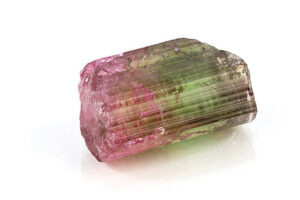Tourmaline: The stone of reconciliation
October birthstone

Physical properties
Tourmaline is a complex boron silicate mineral that occurs in a wide range of colors, including pink, green, blue, yellow, black, and even multicolored varieties like watermelon tourmaline. It has a hardness of 7-7.5 on the Mohs scale, making it durable for jewelry. Tourmaline’s prismatic crystals and vitreous luster give it a striking appearance, and it is often used in both raw and polished forms.
history
Tourmaline has been used for centuries, with ancient civilizations believing it could inspire artistic expression and protect against negative energy. It was highly valued in China, where it was used in carvings and jewelry. In the 18th century, Dutch traders introduced tourmaline to Europe, where it became a favorite among royalty. Today, it is prized for its vibrant colors and metaphysical properties.
Symbolism & Beliefs
Tourmaline is known as the “stone of reconciliation,” symbolizing compassion, balance, and healing. It is believed to protect against negative energy, promote emotional stability, and enhance spiritual growth. Different colors of tourmaline are associated with different chakras, making it a versatile stone for energy work. For example, black tourmaline is linked to grounding, while pink tourmaline is associated with love and emotional healing.

